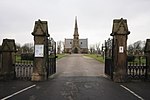St Thomas' Church, Blackpool
20th-century Church of England church buildingsAustin and Paley buildingsChurch of England church buildings in LancashireChurches in BlackpoolDiocese of Blackburn ... and 5 more
English church stubsGothic Revival architecture in LancashireGothic Revival church buildings in EnglandLancashire building and structure stubsUnited Kingdom Anglican church building stubs
St Thomas' Church is in Caunce Street, Blackpool, Lancashire, England. It is an active Anglican parish church in the Deanery of Blackpool, the Archdeaconry of Lancaster and the Diocese of Blackburn.
Excerpt from the Wikipedia article St Thomas' Church, Blackpool (License: CC BY-SA 3.0, Authors).St Thomas' Church, Blackpool
Selbourne Road,
Geographical coordinates (GPS) Address Nearby Places Show on map
Geographical coordinates (GPS)
| Latitude | Longitude |
|---|---|
| N 53.8215 ° | E -3.0396 ° |
Address
Selbourne Road
Selbourne Road
FY1 3SA , Claremont
England, United Kingdom
Open on Google Maps









